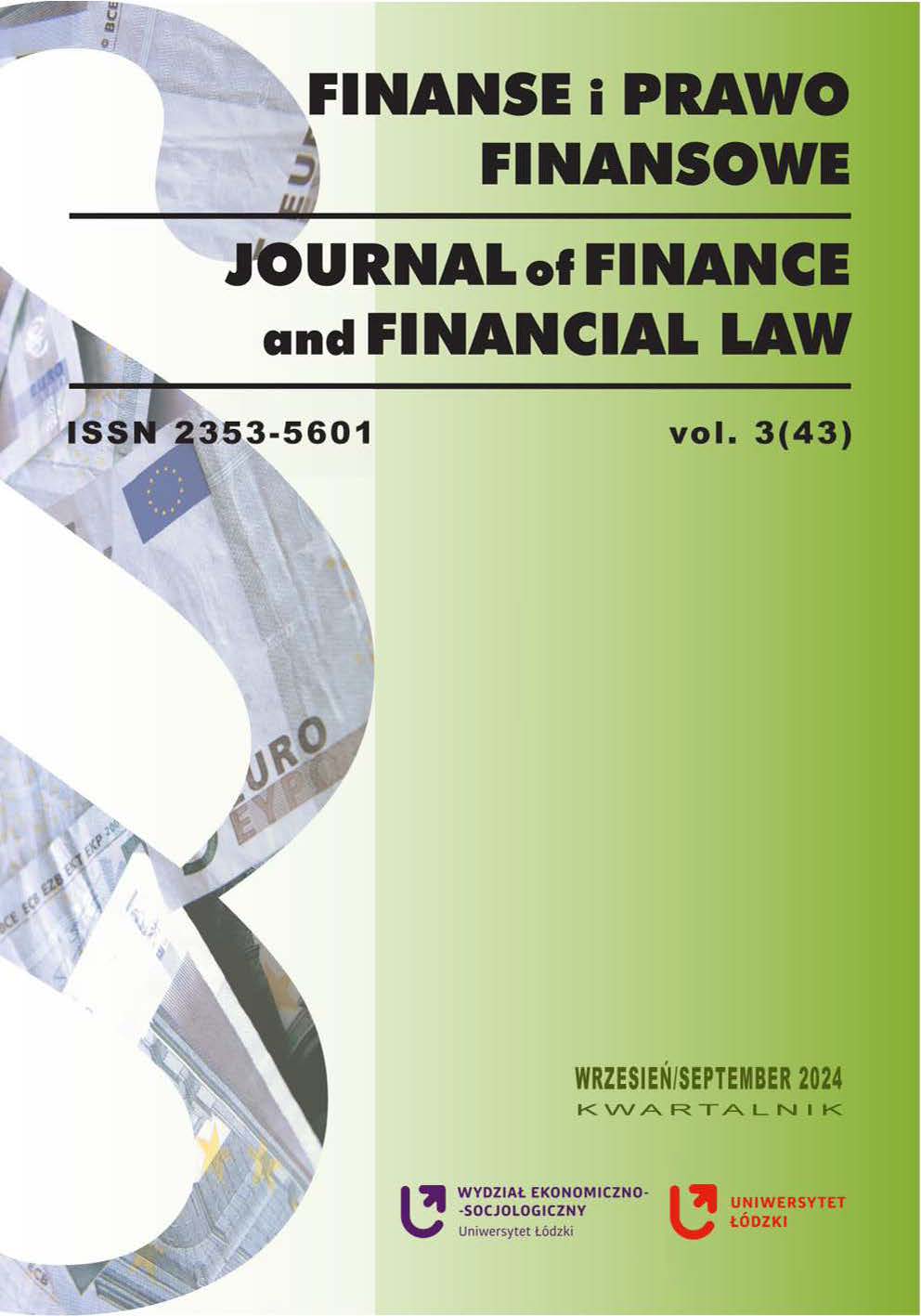Risk Perception versus Risk Preference among Future Financial Market Participants – A Pilot Study
DOI:
https://doi.org/10.18778/2391-6478.3.43.01Keywords:
capital market, investors’ risk aversionAbstract
The purpose of the article. The purpose of this pilot study was to assess the level of risk measured by the SIRI risk questionnaire and the psychological test from the section ‘People Value Changes, not States’ from the article ‘Aspects of Investor Psychology' by Kahneman and Riepe. Another objective was to evaluate the relationship between the level derived from the tests and the risk attitude of market participants.
Methodology. The pilot study was conducted between February and June 2023. A quantitative method was used to verify the hypothesis. A survey tool was used and 36 students of Finance and Accounting major were surveyed. The survey consisted of the SIRI risk questionnaire, the Kahneman and Riepe psychological test, and a metric, which included questions on the socio-demographic characteristics of the sample such as gender, and a year of study.
Results of the research. The pilot study found a negative moderate correlation between stimulus risk and instrumental risk, and a negative moderate correlation between instrumental risk, risk aversion and gambling propensity.
Downloads
References
Berger, D. and Turtle, H.J. (2012). Cross-sectional performance and investor sentiment in a multiple risk factor model. Journal of Banking & Finance, 36(4): 1107–1121.
Google Scholar
DOI: https://doi.org/10.1016/j.jbankfin.2011.11.001
Booth, A.L. and Katic, P. (2013). Cognitive Skills, Gender and Risk Preferences. The Economic Record, 89(284): 19–30.
Google Scholar
DOI: https://doi.org/10.1111/1475-4932.12014
Cabak, A. (2013). Badanie nadmiernej pewności siebie oraz preferencji ryzyka wśród profesjonalnych i nieprofesjonalnych uczestników rynku wraz z próbą wskazania powiązań badanych fenomenów. Psychologia Ekonomiczna, 4: 22–43.
Google Scholar
Dimitri, N., Basili, M. and Gliboa, I. (2003). Cognitive processes and economic behavior. London: Routledge.
Google Scholar
Dudzińska-Bryła, R. (2013). Zasady teorii perspektywy w ocenie decyzji inwestorów na rynku giełdowym. Studia Ekonomiczne, 13: 26–42.
Google Scholar
Eisenbach, T.M. and Schmalz, M. (2015). Anxiety, overconfidence, and excessive risk taking. SSRN Electronic Journal. http://dx.doi.org/10.2139/ssrn.2566464
Google Scholar
DOI: https://doi.org/10.2139/ssrn.2646034
Gajdka, J. (2013). Behawioralne finanse przedsiębiorstw: podstawowe podejścia i koncepcje. Łódź: Wydawnictwo Uniwersytetu Łódzkiego.
Google Scholar
Ho Po-Hsin, Huang, Chia-Wei, Lin, Chih-Yung & Yen, Ju-Fang (2016). CEO overconfidence and financial crisis: Evidence from bank lending and leverage. Journal of Financial Economics, 120(1): 194–209.
Google Scholar
DOI: https://doi.org/10.1016/j.jfineco.2015.04.007
Kahneman, D. (2012). Pułapki myślenia: o myśleniu szybkim i wolnym. Media Rodzina.
Google Scholar
Kahneman, D. and Riepe, M.W. (1998). Aspects of Investor Psychology: Beliefs, Preferences, and Biases Investment Advisors Should Know about. Journal of Portfolio Management, 24(4): 56–66.
Google Scholar
DOI: https://doi.org/10.3905/jpm.1998.409643
Kempf, A., Merkle, Ch., Niessen-Ruenzi, A. (2013). Low Risk and High Return – Affective Attitudes and Stock Market Expectations. European Financial Management, 20(5): 995–1030. https://doi.org/10.1111/eufm.12001
Google Scholar
DOI: https://doi.org/10.1111/eufm.12001
Kotlarek, P. (2014). Racjonalność w ujęciu ekonomii behawioralnej. Studia Ekonomiczne / Uniwersytet Ekonomiczny w Katowicach, 180: 106–116.
Google Scholar
Kübilay, B. and Bayrakdaroğlu, A. (2016). An Empirical Research on Investor Biases in Financial Decision-Making. International Journal of Financial Research, 7(2): 171–182. https://doi.org/10.5430/ijfr.v7n2p171
Google Scholar
DOI: https://doi.org/10.5430/ijfr.v7n2p171
Kubińska, E. (2012). Psychologiczne miary ryzyka inwestycyjnego. Zeszyty Naukowe/Polskie Towarzystkow Ekonomiczne, 12: 239–247.
Google Scholar
Kumar, A.A. and Babu, M. (2014). Effect Of Loss Aversion Bias On Investment Decision: A Study. Journal of Emerging Technologies and Innovative Research, 5(11): 71–76.
Google Scholar
Lindner, F. et al. (2021). Social Motives and Risk-Taking in Investment Decisions. Journal of Economic Dynamics and Control, 127: 104–116. https://doi.org/10.1016/j.jedc.2021.104116
Google Scholar
DOI: https://doi.org/10.1016/j.jedc.2021.104116
Lippi, A., Barbieri, L., Piva, M. and De Bondt, W. (2023). Time-varying risk behavior and prior investment outcomes: Evidence from Italy. Judgment and Decision Making, 13(5): 471–483. https://doi.org/10.1017/S1930297500008755
Google Scholar
DOI: https://doi.org/10.1017/S1930297500008755
Mahina, J.N., Muuri, W.M. anf Memba, F.S. (2017). Influence of loss aversion bias on investment at the Rwanda Stock Exchange. International Journal of Social Sciences and Information Technology, 3(4): 1917–1932.
Google Scholar
Makarowski, R. (2012). Kwestionariusz Ryzyka Stymulacyjnego i Ryzyka Instrumentalnego (KRSiRI) – nie tylko dla sportowców. Psychologic Journal, 335–346.
Google Scholar
Massa, M. and Simonov, A. (2005). Behavioral Biases and Investment. Review of Finance, 9(4): 483–507. https://doi.org/10.1007/s10679-005-4998-y
Google Scholar
DOI: https://doi.org/10.1007/s10679-005-4998-y
Minsky, H. (1977). A Theory of Systemic Fragility. In: E.D. Altman and A.W. Sametz, eds., Financial Crises: Institutions and Markets in a Fragile Environment. New York, NY: John Wiley and Sons, 138–152.
Google Scholar
Pawlonak, T. (2021). Stosunek do ryzyka a kontekst decyzyjny w świetle teorii perspektywy – wyniki badań eksperymentalnych. In: M. Wasilewski, A. Wasilewska, eds., Wyzwania współczesnych finansów. Warszawa: Wydawnictwo SGGW, 119–130.
Google Scholar
Pompian, M.M. (2017). Risk tolerance and behavioral finance. Investments and Wealth monitor, 20(31): 34–45.
Google Scholar
Rahmawati, et al. (2015). Determinants of the Risk Tolerance of Individual Investors. International Journal of Economics and Financial Issues, 5: 373–378.
Google Scholar
Ruqayya, A. (2023). Investor psychology in the stock market: An empirical study of the impact of overconfidence on firm valuation. Borsa Istanbul Review, 23(1): 93–112. https://doi.org/10.1016/j.bir.2022.09.010
Google Scholar
DOI: https://doi.org/10.1016/j.bir.2022.09.010
Sperandeo, V. (1998). Trader vic: metody mistrza Wall Street. Warszawa: Dom Wydawniczy ABC.
Google Scholar
Syed Zain ul Abdin, Fiza Qureshi, Jawad Iqbal, Sayema Sultana (2022). Overconfidence bias and investment performance: A mediating effect of risk propensity. Borsa Istanbul Review, 22(4): pp. 780–793. https://doi.org/10.1016/j.bir.2022.03.001
Google Scholar
DOI: https://doi.org/10.1016/j.bir.2022.03.001
Tyszka, T. (2010). Decyzje. Perspektywa psychologiczna i ekonomiczna. In: W.J. Brzeziński, eds., Wykłady z psychologii. Warszawa: Wydawnictwo Naukowe Scholar.
Google Scholar
Von Neumann, J., and Morgenstern, O. (1944). Theory of games and economic behavior. Princeton University Press.
Google Scholar
Walasek, L. and Stewart, N. (2015). How to Make Loss Aversion Disappear and Reverse: Tests of the Decision by Sampling Origin of Loss Aversion. Journal of Experimental Psychology. General, 144(1): 7–11. https://doi.org/10.1037/xge0000039
Google Scholar
DOI: https://doi.org/10.1037/xge0000039
Zaleśkiewicz, T. (2001). Beyond Risk Seeking and Risk Aversion: Personality and the Dual Nature of Economic Risk Taking. European Journal of Personality, 15(51): 105–122. https://doi.org/10.1002/per.426
Google Scholar
DOI: https://doi.org/10.1002/per.426
Żurawik, B. (2012). Irracjonalność zachowań inwestorów giełdowych. Zarządzanie i Finanse, 2(2): 203–218.
Google Scholar
Downloads
Published
How to Cite
Issue
Section
License

This work is licensed under a Creative Commons Attribution-NonCommercial-NoDerivatives 4.0 International License.














